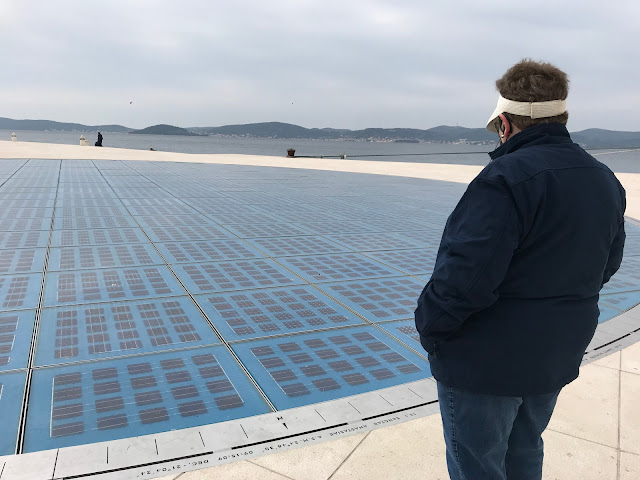March 18, 2022
52 degrees, but the temperature doesn't tell the whole story. If it's windy, you're cold. If not, it's time to peel off the jacket.
Forgetfulness heals everything and song is the most beautiful manner of forgetting, for in song man feels only what he loves. ~ Ivo Andrić, Croatian author of The Bridge on the Drina
Zadar greets all its visitors with song!
In 2018, we spent a magical day in the Croatian countryside at Krka National Park, wandering amid the waterfalls. Today, we stayed in the town of Zadar, which we'd missed completely before. The Star docked right next to the "sea organ"--a system of pipes built under the walkway along the seashore--that sings random tones as the waves push air out of the pipes. I love the "keyboard" seating area that runs in a crescent shape along the seawalk. The organ doesn't have a recognizable tonality. The sounds it makes are more organic and whale-song-ish, but no less haunting for all that.There's also a model of the solar system built into the walkway that's fitted with solar panels which makes the sun and all its planets shine at night. (Only 8. This was built after Pluto was kicked out.) The heavenly bodies are all to scale as regards size, but not in relative distance from each other. That would put the outer planets about 25 miles from the waterfront. Unfortunately, we sailed away before it was dark enough to see the sun and planets shine, but what a whimsical waterfront Zadar has!
 |
| Kristy & the "sun." |
Our guide Benjamin proved a fount of information about the history of Croatia and Zadar in particular as he led us up a slight incline past part of the ancient city walls to some Roman ruins. They are a given in every Mediterranean port, but part of what made these interesting is that we were able to see how later kingdoms used the pillars left by Rome to serve as a base for their later buildings.
 |
Then we were led through a museum run by the Benedictine sisters who, for hundreds of years, kept a dragon's hoard of religious art hidden from those (read: Venetians, Ottomans, Napoleon and others) who would have claimed them as if by right. The nuns had a system of false walls in their convent and a vow of silence in their order. The treasures were sealed away until they were finally revealed in the 1950's. Unfortunately, we were not allowed to take photos inside the extensive exhibit of reliquaries, paintings and statuary, but it was a dazzling collection, sparkling with gold and silver.
Inside the monastery we learned that the earlier paintings of the Madonna and Child which depicts them cheek to cheek were Byzantine in provenance. The images emphasized the humanity of Christ. Later paintings showed the baby Jesus perched on his mother's lap with no real connection between them, but with both of them haloed and deified.Not being Catholic, there's much I don't understand about relics and their importance to the faithful, but I was fascinated to learn that a body purported to be Simeon, the man to whom God had revealed that he wouldn't die until he had seen the Lord's Christ, is entombed in a local church that bears his name. There have been tests done on the remains and while no test can prove those are Simeon's bones, they are the right age to have been the old man who held Jesus on the day of His circumcision and prophesied to Mary that a "sword would pierce" her own soul also. Simeon, and his female counterpart Anna who was also a prophetess, have always intrigued me. They must have had a very intimate relationship with God since they recognized Jesus on sight.
Maybe the point of recognizing the saints of the past is so their faith will inspire and strengthen ours.
Benjamin led us down the ramrod straight main street to the Church of St. Anastasia, another patron of Zadar, and let us wander through the church on our own while he delivered a description of what we seeing inside through the use of our Quiet Vox. This handy little devices fit in our pockets with an earpiece on a wire that allows all our guides communicate with us even if we are spread out over a wide area.
This came in very handy when one of the other lady's husbands in our group went missing after we came out of the church. He'd wandered down one of the nearby lanes, but came back quickly enough when he heard Benjamin offer to find the lady a new husband.
It seems every place has its unique alcoholic production. Our next stop was a distillery that sells a spirit called Maraschiano, made from cherries. We were all treated to a little taste. It reminded me of cough syrup and went down as sweetly and smoothly. And since it was a bit of a chilly day, the warmth that followed it was welcome!
Like all the places we've previously visited, we enjoyed discovering new things about Zadar. Croatia is a beautiful country with bright, well-spoken, and quick-witted citizens, if Benjamin is any proof. Kristy was delighted to learn that his wife is a kindergarten teacher, just like she was.
Here's the DH's photo montage:




We’ve not had the pleasure of calling on Zadar yet …sounds like a lovely place.
ReplyDelete